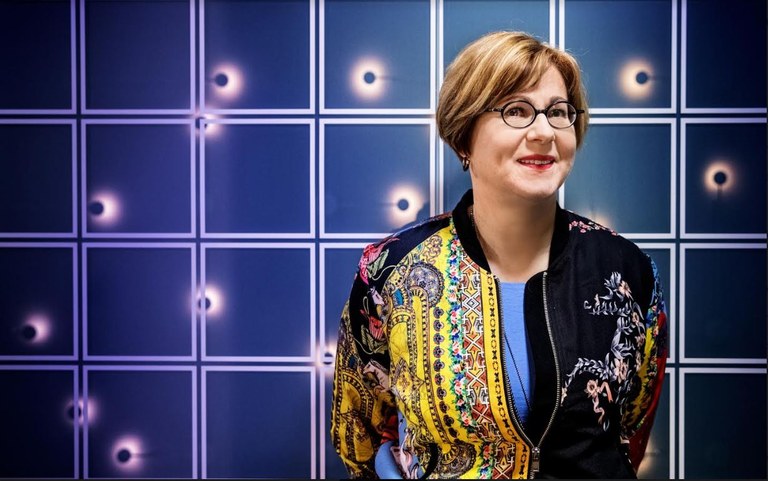Marjo Bruun: The new economy is a statistical challenge
Marjo Bruun, Director General for Statistics Finland, considers journalists to be the most important partners in the fight for honest words and digits.
Director General Marjo Bruun meets us at Statistics Finland’s office in Helsinki’s Kalasatama district – a new neighbourhood growing out of the ruins of what was once a wasteland and container terminals. The morning before our interview, Statistics Finland presented their newest report, Entrepreneurs 2017, where the agency for the first time gather all kinds of entrepreneurs in one statistics report. 13 percent of Finnish workers are self-employed or running small businesses, the report says.
These days, when people in many countries question the credibility of social institutions, and media are called the enemy of the people, it is worth asking whether statistics agencies also come under the same kind of pressure.
Is there criticism of the job you are doing and your statistics?
“Of course things expressed in social media are critical and question everything – some still question whether the Earth is round. But: by and large, the Finnish people’s trust in authorities and public statistics is still pretty high.”
Marjo Bruun says that the debate over whether statistics really stand up to scrutiny pops up every so often. Statistics covering how you calculate the employment rate or unemployment often create debate and some misunderstandings. One reason there are misunderstandings about Finland’s unemployment rate is the fact that there are two versions of the statistic: one is Statistics Finland’s labour force survey which follows the common European way of measuring unemployment by taking samples. The other is the Ministry of Economic Affairs and Employment’s job centre statistics, which counts the number of people who have registered as unemployed. In October 2018, there were 171.000 unemployed people in Finland (according to Statistics Finland), while at the same time there were 230.100 unemployed job seekers (according to the ministry).
But if there is a misunderstanding, have the statistics professionals really managed to explain the statistics in a way that people understand?
“A very large part of our statistics is open to the public on our website, and there we also try to analyse and explain the statistics. But in reality one of our most important jobs is to succeed in conveying our statistics to the media – and they then present the statistics with examples and single individuals’ situation – this is really our best way of reaching out to the general public.”
Marjo Bruun says that Statistics Finland spends a lot of time figuring out how a new social phenomenon should be studied and how to create statistics around it. She uses the platform economy as an example.
“This is a phenomenon which is hard to describe in simple figures – and we are working with that issue right now.”
Globalisation is another major issue which has challenged statisticians.
“Where does added value emerge: where is product planning taking place, where is the product made, where do the raw materials come from, where is the product being packaged, where is the product assembled, where is the service performed? All this can happen in different countries and it becomes important to find out which countries are considered to be the producers.”
Statistics as a tool against fake news
In its 2017 annual report, Statistics Norway (SSB) wrote that “SSB acts as Norway’s first line of defence in the fight against fake news by providing objective and relevant statistics, research and analysis to help understand Norway.”
What role does Statistics Finland play in the fight against fake news?
“In a way this is the basic role of a statistics agency, that is true. But to what extent do we have the chance to make this happen. Take social media – no-one can follow everything that is written there.”

After this somewhat resigned and tentative first part of her answer, she follows up a bit more enthusiastically:
“But it is an interesting thought. Our mandate is to produce fact-based information so that anyone who needs to can use it. We also want to make sure that the correct figures are used as the basis for public debate.”
Marjo Bruun reminds us that it is important to always highlight the scientific method, how the information is gathered and presented.
“The information we create is close to reality. We cannot reach absolute truth, but we base everything on samples, which is always what you do in statistics.”
Then she comes up with an interesting example – which illustrates that a state authority has not been content with just saying “please check out the statistics on our website”. Bruun tells us that Statistics Finland has entered into cooperation with the journalist collective Faktabaari (the Facts Bar). It acts, just like similar fact checkers in other countries, as an independent fact checker of politicians’ or other players’ pronouncements, and brings that information out to people in general.
“Next spring there are parliamentary elections in Finland. During electioneering, politicians will make various statistical claims – things like how tax cuts might influence society, how many unemployed people there are in Finland, how many employed?”
Bruun says that Statistics Finland and Faktabaari will present numbers and statistics which will allow people to examine the politicians’ claims. At the same time politicians’ support groups will voluntarily contact Statistics Finland in order to access statistics which will allow them to present fact-based proposals in the run-up to the election.
How will the statistics agency’s task change in the light of the possibilities presented by new technology and the gathering of huge amounts of information (big data)?
“This means massive change. And this is where we return to the debate about Statistics Finland’s role in the so-called fake news world. The large amounts of data and our ability to refer to our sources will allow us to help improve the trust in scientific facts. There is an appetite for this – just like there is an increased demand for quality journalism in the world right now.”

Marjo Bruun also reminds us that today’s busy world has made it difficult for many of those who work with data gathering; fewer and fewer people take time to answer questions over the telephone or via email. Statisticians must find new ways of getting hold of the data needed to present the correct numbers to the world.
“It is important that we manage to use all this information in a responsible way for the common good. We have to be mindful of the users’ interests, the commissioners’ interests and of course we have to make sure we safeguard integrity and data protection.”
- One minute interview
-
What book are you reading?
I am listening to Annika Sjögren’s ”Ur havet stiger vågorna”, and I am reading Isaac Asimov’s “Prelude to Foundation”. In the evening I read aloud from Minna Lindgren’s ”The End of Sunset Grove”.
What is your favourite tool in the office?
The discussions with our experts and with people who belong to Statistics Finland’s broad network are very inspiring and give me new ideas.
What did you want to become as a child?
I loved and admired my grandmother, so I also wanted to become a grandmother. Today I have two wonderful grandchildren.
What is your hidden talent?
Perhaps not so hidden, but I am pretty handy – which often helps.
- Facts about Marjo Bruun
-
- Graduated from the University of Helsinki with a degree in agriculture in 1988.
- Worked as a specialist and consultant in the private sector. Between 2007–2012, Marjo Bruun was Director General of the Information Centre of the Ministry of Agriculture and Forestry (Tike).
- She is the chair of the Conference of European Statisticians (CES) and its board, which answers to the UN’s Economic Commission for Europe until June 2019.
- Marjo Bruun became fascinated by science during her years in upper secondary education, especially mathematics and probability theory.
 Follow us on Facebook
Follow us on Facebook
